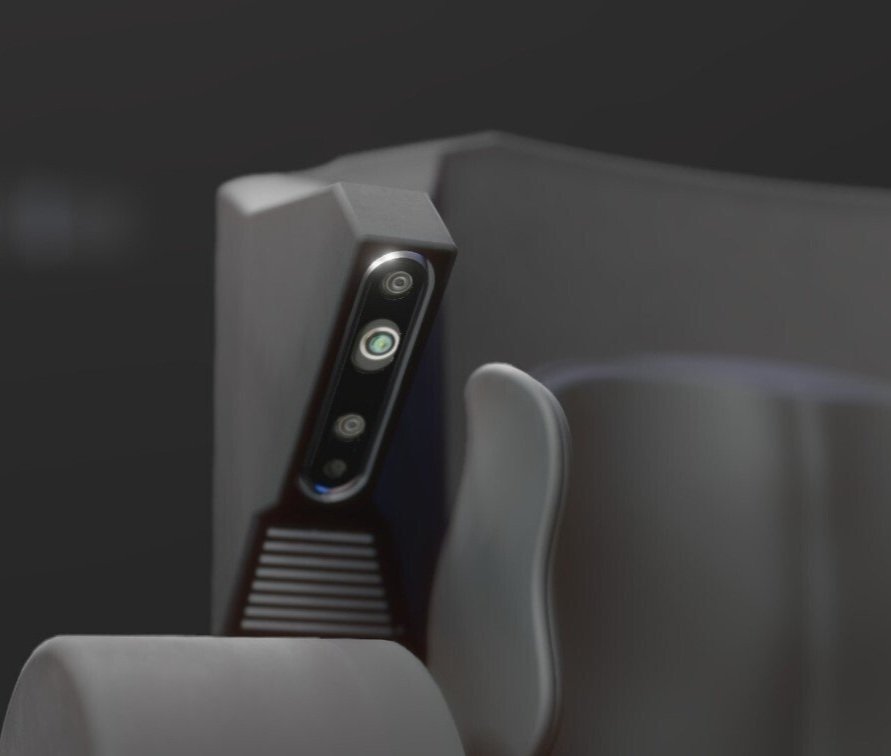Design MARCH VI
The MARCH VI is the sixth prototype in the series of Project MARCH exoskeletons. On March 25, 2021, the sixth team presented the design of this exoskeleton and the challenges they face with it. The biggest challenge: making the exoskeleton dynamic and user-friendly. The goal is not to go faster, but to go and stand where the exoskeleton has not been before: outside. This page explains how the sixth team took on these design challenges.
Depth cameras
To make the exoskeleton walk dynamically, the exoskeleton has to gain information about the environment. And use this data to calculate and predict its next steps. To collect this data the sixth team implemented a new sensor, a depth camera. This depth camera serves as the eyes of the exoskeleton. Similar to the biological process, the camera extracts 3D information from digital images by comparing information about a scene from two vantage points. The software translates this information into regions where the exoskeleton can walk and calculates how to adjust the steps.
Input Device
Last few years the pilot controlled the movements of the exoskeleton via the input device attached to the crutches. This remote is well developed by the previous MARCH teams. The sixth team made the necessary adjustments to meet Koens preferences.
Model predictive control
A new method to control the joints is implemented, called ‘Model Predictive Control’. Dynamic models of the joints are used to simulate and optimize their future state. Making it possible to predict the optimal torque necessary for tracking the gait. The exoskeleton will be able to anticipate the movements, rather than react to them. Which makes the movements of the exoskeleton smoother.
Hinge for ease acces
There is also a new feature in our frame design: a hinge. This hinge creates the opportunity to aim for user-friendliness not only while using the exoskeleton but also during the transfer from the wheelchair to the exoskeleton. A hinge enables the pilot to move the legs of the exoskeleton an extra 60 degrees apart creating more space, making the transfer easier, faster, and safer.
Joints
The joints are of paramount importance. These are the muscles of the exoskeleton. The sixth team has implemented a motorized hip, knee, and ankle. Compared to previous years, the new rotational joints, the hip, and knee are thinner and more importantly, able to reach higher torque. With an impressive increase of 70% to 250 Nm. Because the joints can reach higher speeds the exoskeleton can react quicker to the input of the sensors. Therefore, walking becomes less straining.
Backpack electronics
When an exoskeleton is designed for outdoor and daily life use, new requirements arise compared to a one-time run for competition. It should be possible to use the exoskeleton for a longer amount of time. So the sixth team doubled the battery capacity. As a result, the exoskeleton can walk further.
Ease of use has also been considered. That is why the battery, which is located in the backpack, can easily be removed using a quick-release mechanism if it needs to be recharged.
In the backpack, you can also find the power distribution board which ensures that all electronic components receive power from the battery. The board was made as compact as possible by optimizing the placement of components.
3D topology optimization
The sixth team optimized the material use of the frame. With topology optimization in 3D, they were able to decrease the weight of the bones while maintaining the ability to safely bear all forces.
Additionally, the implementation of a flexible footplate, made out of carbon, also reduced the amount of weight, can bear all forces, and deform the natural motion of the foot.
Odrive motorcontroller
The performance of an electric motor in the joints is coordinated in a predetermined manner by a device called a motor controller. To improve the reliability of the exoskeleton, a new motor controller was selected. The ODrive, an open-source motor controller. The sixth team is proud to contribute to the development of its firmware.
Software
Looking at the overall software development, the sixth team mostly focused on smaller improvements to make the software more reliable and future-proof. One of these improvements is that they have upgraded the software to use the latest framework in robotics. In addition, they have a new and more powerful computer in the backpack. So they are able to make more complex computations during every data cycle. This was necessary because more data is collected due to the implementation of the depth camera.
Pressure soles
Due to the challenge of uneven terrain, balance is even more important than in previous years. The exoskeleton should not take a step when the weight of the pilot is still located above the foot. Lifting this foot will create even more instability. To know on which foot the pilot's weights rests, pressure soles are needed. These soles measure the pressure on eight different locations in the foot, enabling a more accurate estimation of the pilot's balance.
Fixtures
The fixtures are the parts that connect the pilot to the exoskeleton. They are shaped exactly to match Koen's body.
The torso fixture has now been enriched with a pouch, in an effort to make the exoskeleton more user-friendly and ready for future daily use. Regarding the upper leg fixtures, the improved connection pieces and the new way of closing them both contribute to an easier, faster but also more comfortable transfer. The lower leg fixtures and their connection to the frame contain the biggest concept changes. Previous teams fixated the shins with carbon. Now the sixth team turned the fixture around and fixated the calves since those are less sensitive parts of our body.












